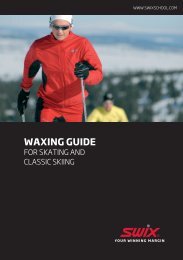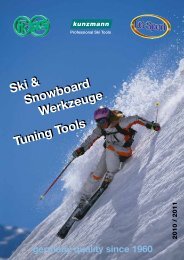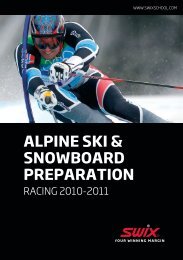NORDIC SKI PREPARATION
NORDIC SKI PREPARATION
NORDIC SKI PREPARATION
Create successful ePaper yourself
Turn your PDF publications into a flip-book with our unique Google optimized e-Paper software.
BASE STRUCTURES AND<br />
SWIX RILLING / IMPRINT TOOLS<br />
Structure is a term used to describe patterns<br />
cut into the base to reduce base contact on the<br />
snow and to release surface tension from water<br />
films caused by base friction. These structure patterns<br />
are most often produced by stone grinding<br />
machines at the factory during production or by<br />
shops that specialize in the stone grinding process.<br />
It is also possible to produce structures using<br />
hand tools.<br />
For a period of time there was much experimentation<br />
and testing of many types of patterns<br />
in order to find the best structure for different<br />
snow types. The search with different stone<br />
grinders, different structure depths, widths,<br />
and patterns, all aiming to find “the ultimate<br />
structure”, was overwhelming. Recently however,<br />
the development showed signs of simplification.<br />
Now service technicians agree more that<br />
snow types can be classified in more general<br />
terms to which more certain structure patterns<br />
can be matched. An appropriate structure is still<br />
of absolute importance, but it is applied with a<br />
set of basic principles in mind. The result is that<br />
variations in machine set structures are fewer<br />
and standardized. The tendency to “simplify”<br />
variations in stone grinding can allow for a more<br />
accurate comparison of other significant factors<br />
such as skis and waxes, and in theory it is possible<br />
to travel with fewer pairs of skis.<br />
Last but not least, structures made by hand<br />
on top of structures produced by machine have<br />
proven to give outstanding results. Manually set<br />
structures in combination with stone grinding can<br />
match the day’s conditions more accurately and<br />
therefore enhance the effectiveness of a basic<br />
stone ground base.<br />
There is an important difference between<br />
structures produced by machine and those produced<br />
by hand. Stone ground structures are cut<br />
into the base, and are more permanent in nature.<br />
Hand structures use “imprint” tools that press<br />
the structure into the base, and consequently are<br />
temporary.<br />
Swix imprint tools have the advantage of<br />
being easy and quick to use while at the same<br />
time offer the most adaptability of adjusting the<br />
structure to match the snow type. During the process<br />
of rewaxing the heat from the iron will cause<br />
the pattern to leave the base while keeping the<br />
stone ground pattern intact. In this way the base<br />
is ready once again for the next hand produced<br />
structure treatment and it is possible to apply the<br />
perfectly matching structure according to the<br />
conditions of the day.<br />
Although there are variations in the patterns<br />
applied, structures can be classified into “fine”,<br />
“medium-fine”, “medium-coarse” and “coarse”<br />
structures. The most frequently used structures<br />
in World Cup are “fine” and “medium-fine”.<br />
For classic races more coarse structures are used<br />
as well. The difference between classic and skating<br />
is related to more varying conditions in a skating<br />
coarse than in a classic track. Also the factor of<br />
“feeling” that has to do with the resistance when<br />
“pushing” the ski forward is significant in skating,<br />
but less in classic. The “free feeling” can be lost,<br />
especially when skating uphill, when the structure<br />
is too coarse.<br />
Four Different Grades of<br />
Stone Grinding<br />
The Norwegian XC-team has introduced a color<br />
coding system to select corresponding skis and<br />
structure of the glide zone:<br />
Green (-5°C and colder): Fine<br />
Blue (0°C to -5°C): Medium/Fine<br />
White (0°C to+3°C - moist): Medium/Coarse<br />
Red (+1°C to +10°C - wet): Coarse<br />
It is normal to apply two or more labels on the skis.<br />
At the tip the colored labels (one or two) indicate<br />
actual snow condition range for the actual pair,<br />
i.e. green and blue. In front of the binding there<br />
is only one label, i.e. green, to indicate existing<br />
structure. For optimal performance of this pair in<br />
“blue” snow conditions, it is therefore necessary<br />
to run a hand-made structure to transform “Fine”<br />
to “Medium / Fine”. In this way, good skis might be<br />
utilized in more snow conditions. In addition, the<br />
number of skis taken to races is perhaps reduced.<br />
In free-technique (skating) the coarse structure<br />
is seldom used. Consequently, a free-technique<br />
ski for wet, coarse-grained snow often has<br />
a red label on the tip and a white label in front of<br />
the binding.<br />
Fine structures:<br />
Fine structures are mainly used on new snow and<br />
fine grained snow. For skating; fine structures are<br />
normally used from 0°C (32°F) and colder, for classic;<br />
-5°C (23°F) and colder.<br />
Sharp crystals (present in dry new/fine snow)<br />
and a sharp structure is not optimal. A newly<br />
set (fresh) structure will in general give a<br />
“sharp” structure. In dry, cold, new and fine<br />
snow conditions (usually lower than -7°C<br />
(19°F)), the fine “sharp” structure should be<br />
“rounded” with Fibertex T264 (or a plexi scraper).<br />
Though, this process is normally more important<br />
for skating than for classic skiing. On the other<br />
hand, in new snow with high humidity close to 0°C<br />
(32°F) the structure should preferably be sharper.<br />
Medium/Fine structures:<br />
This structure is a widely used structure.<br />
For skating it is used in most snow conditions<br />
normally from -7°C (19°F) up to wet snow.<br />
In very wet conditions a medium/fine structure<br />
combined with the use of an imprint tool has<br />
proven good results.<br />
For classic skiing we recommend this structure<br />
in new and fine grained snow (normally<br />
between -7°C (19°F) and 0°C (32°F)).<br />
STRUCTURE EXAMPLES<br />
FINE<br />
MEDIUM/FINE<br />
COARSE<br />
4 5





